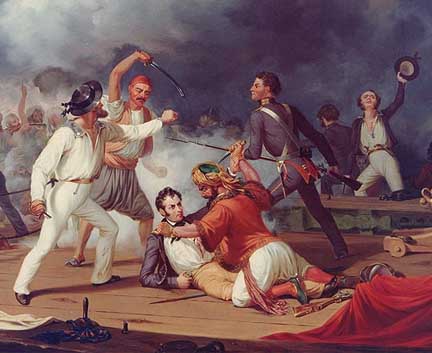“Everybody says this here thing we’re involved in ain’t a real war. Congress says it ain’t a war. The President says it ain’t a war. ‘Course the guys over there getting shot at say it’s the best damned imitation they ever saw.” -Will Rogers
 America’s men and women in uniform are once again in harm’s way. Last week, the U.S. launched a series of deadly attacks on terrorist targets in Syria. Some in Washington are going out of their way to avoid calling it a war; others are almost enthusiastically using the same word. I’m not getting into that debate. But it does raise an interesting question: at what point does an armed conflict become a war?
America’s men and women in uniform are once again in harm’s way. Last week, the U.S. launched a series of deadly attacks on terrorist targets in Syria. Some in Washington are going out of their way to avoid calling it a war; others are almost enthusiastically using the same word. I’m not getting into that debate. But it does raise an interesting question: at what point does an armed conflict become a war?
It used to be straightforward and simple. One nation officially declared war on another nation, and the fight was on. (Side note: the U.S. has only declared war five times: the War of 1812, the Mexican-American War, the Spanish-American War, World Wars I and II.)
Nothing these days is as simple as it used to be. Nobody has wanted to take the blame for an unpopular war ever since political opponents personalized the War of 1812 as “Mr. Madison’s War” and hung it around poor Jimmy’s neck.
So instead we now have “Congressionally sanctioned military operations.”
This is hardly a new thing. Believe it or not, the United States has fought undeclared wars for nearly 220 years. Let’s hop into the Wayback Machine and look at some of them.
 1798 The Quasi War: The federal government was only nine years-old, and Congress was already looking for ways to fight a war without declaring war. During the Revolutionary War, France had tipped the scales our way by sending their fleet and loaning us lots of money. After Cornwallis surrendered, France proceeded to have a revolution of its own, lopping off King Louis’ head and replacing the monarchy with a hurly-burly republic. The newly created United States of America seized on this development to stop repaying the debt (the loan was made by the King, Congress argued; we didn’t owe anything to the republican government that followed him.) The French were naturally ticked off and decided to get the money one way or another. So they attacked American merchant ships on the high seas. Congress authorized U.S. warships to fire back. Over the next two years, some 70 Americans and more than 400 Frenchmen were killed and wounded in fighting on the high seas.
1798 The Quasi War: The federal government was only nine years-old, and Congress was already looking for ways to fight a war without declaring war. During the Revolutionary War, France had tipped the scales our way by sending their fleet and loaning us lots of money. After Cornwallis surrendered, France proceeded to have a revolution of its own, lopping off King Louis’ head and replacing the monarchy with a hurly-burly republic. The newly created United States of America seized on this development to stop repaying the debt (the loan was made by the King, Congress argued; we didn’t owe anything to the republican government that followed him.) The French were naturally ticked off and decided to get the money one way or another. So they attacked American merchant ships on the high seas. Congress authorized U.S. warships to fire back. Over the next two years, some 70 Americans and more than 400 Frenchmen were killed and wounded in fighting on the high seas.
 1802 & 1815 The Barbary Pirate Wars: Remember the opening line of the Marine Hymn? “From the Halls of Montezuma, to the shores of Tripoli…” The shores of Tripoli part refers to these undeclared wars. Pirates from the Barbary States (parts of modern Libya, Algiers, Tunis and Morocco) were seizing U.S. Navy ships, taking sailors hostage and holding them in exchange for astronomically high ransom. Congress told the Navy, “Go get ‘em.” The resulting fighting claimed 113 Americans and 2,053 pirates killed and wounded.
1802 & 1815 The Barbary Pirate Wars: Remember the opening line of the Marine Hymn? “From the Halls of Montezuma, to the shores of Tripoli…” The shores of Tripoli part refers to these undeclared wars. Pirates from the Barbary States (parts of modern Libya, Algiers, Tunis and Morocco) were seizing U.S. Navy ships, taking sailors hostage and holding them in exchange for astronomically high ransom. Congress told the Navy, “Go get ‘em.” The resulting fighting claimed 113 Americans and 2,053 pirates killed and wounded.
 1861 The American Civil War: That’s right, our nation’s bloodiest conflict wasn’t a declared war. You see, war can only be declared by one country against another. The North didn’t recognize the Confederacy as a sovereign nation. So Congress instead declared a state of rebellion within the seceded states. In fact, the federal government still officially calls it The War of the Rebellion.
1861 The American Civil War: That’s right, our nation’s bloodiest conflict wasn’t a declared war. You see, war can only be declared by one country against another. The North didn’t recognize the Confederacy as a sovereign nation. So Congress instead declared a state of rebellion within the seceded states. In fact, the federal government still officially calls it The War of the Rebellion.
 1849-1886 The Apache Wars: Think the Iraq War was America’s longest conflict? Or maybe Vietnam? Think again. America was expanding westward in the 1800s, but the Apaches said, “Not on our land.” So they fought. And fought. And fought. In fact, the fighting was so prolonged, there was rarely a 90-day stretch of peace during this 37 year era. The Apaches even fought against the Confederates during the Civil War. Violence tapered off after 1886, but there were sporadic battles as late as 1924.
1849-1886 The Apache Wars: Think the Iraq War was America’s longest conflict? Or maybe Vietnam? Think again. America was expanding westward in the 1800s, but the Apaches said, “Not on our land.” So they fought. And fought. And fought. In fact, the fighting was so prolonged, there was rarely a 90-day stretch of peace during this 37 year era. The Apaches even fought against the Confederates during the Civil War. Violence tapered off after 1886, but there were sporadic battles as late as 1924.
 1899-1902 The U.S.-Philippine War: The 1898 Spanish-American War was called “a splendid little war,” because in a conflict that only lasted 3 months, 2 weeks and 4 days, the U.S. won Cuba, Puerto Rico and the Philippine Islands. The only problem was, many Filipinos believed America’s high-toned rhetoric about overthrowing their tyrannical Spanish masters and tasting freedom. And they thought that freedom entailed self-government. Washington didn’t agree, and sent 126,000 soldiers, sailors and marines to prove its point. A particularly savage war ensued. When it ended three years later, 9,165 Americans and perhaps as many as 20,000 Filipinos had been killed and wounded.
1899-1902 The U.S.-Philippine War: The 1898 Spanish-American War was called “a splendid little war,” because in a conflict that only lasted 3 months, 2 weeks and 4 days, the U.S. won Cuba, Puerto Rico and the Philippine Islands. The only problem was, many Filipinos believed America’s high-toned rhetoric about overthrowing their tyrannical Spanish masters and tasting freedom. And they thought that freedom entailed self-government. Washington didn’t agree, and sent 126,000 soldiers, sailors and marines to prove its point. A particularly savage war ensued. When it ended three years later, 9,165 Americans and perhaps as many as 20,000 Filipinos had been killed and wounded.
 1918-1919 The Russian Civil War: Yes, you read right … the United States was actually involved in Russia’s Civil War. The Czar was overthrown and murdered, and civil war soon broke out between the Reds (Communists) and the Whites (the anti-Bolsheviks, some of whom were pro-democracy while others wanted the Romanov dynasty restored). In the wake of World War I, there was a Red Scare in the United States, just as there was again in the wake of World War II, with people fearing Communism would spread to this country. So President Woodrow Wilson joined an international military force aimed at stopping it. Some 5,000 U.S. soldiers of the American North Russia Expeditionary Force (nicknamed the Polar Bear Express) were sent to Arkhangelsk while another 8,000, called the American Expeditionary Force Siberia, were shipped to Vladivostok. That’s right: 13,000 U.S. troops were on Russian soil. It quickly became apparent the Whites were losing the struggle; and with Americans still war-weary from the trenches of France, our men were soon recalled. But 424 Americans died during the debacle.
1918-1919 The Russian Civil War: Yes, you read right … the United States was actually involved in Russia’s Civil War. The Czar was overthrown and murdered, and civil war soon broke out between the Reds (Communists) and the Whites (the anti-Bolsheviks, some of whom were pro-democracy while others wanted the Romanov dynasty restored). In the wake of World War I, there was a Red Scare in the United States, just as there was again in the wake of World War II, with people fearing Communism would spread to this country. So President Woodrow Wilson joined an international military force aimed at stopping it. Some 5,000 U.S. soldiers of the American North Russia Expeditionary Force (nicknamed the Polar Bear Express) were sent to Arkhangelsk while another 8,000, called the American Expeditionary Force Siberia, were shipped to Vladivostok. That’s right: 13,000 U.S. troops were on Russian soil. It quickly became apparent the Whites were losing the struggle; and with Americans still war-weary from the trenches of France, our men were soon recalled. But 424 Americans died during the debacle.
 I could go on because there are lots more examples of undeclared wars, but you get the idea. Politicians and pundits may squabble about whether the current military action in Syria is a war, but that’s nothing new. As Will Rogers so rightly put it in the quote at the start of this post, when you’re being shot at, does it really matter what name is being used? Not really.
I could go on because there are lots more examples of undeclared wars, but you get the idea. Politicians and pundits may squabble about whether the current military action in Syria is a war, but that’s nothing new. As Will Rogers so rightly put it in the quote at the start of this post, when you’re being shot at, does it really matter what name is being used? Not really.
Did you find this enjoyable or helpful? Please continue to join me each week, and I invite you to read Tell it Like Tupper and share your review!
Curious about about Tell It Like Tupper? Here’s a chance to see for yourself. Take a sneak peek at a couple chapters in this free downloadable excerpt.

Pingback: Ready, Set – Surrender! - J. Mark Powell